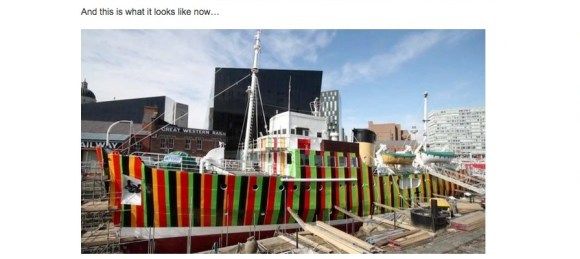
A retired pilot ship sits in a Liverpool dock, painted in vivid red, yellow and green stripes. This is a “Dazzle Ship”, decorated with a unique and eccentric British camouflage method originally developed during World War One.
The British navy had tried different methods of disguising ships, but none had proved effective. Realising that it must be impossible to successfully conceal a boat, marine artist Norman Wilkinson suggested a radical, opposite approach: a design that would instead confuse and disorientate the enemy, making it difficult for a U-boat commander to estimate the boat’s speed or direction. The Dazzle Ship was born.
The pilot ship currently on show in Liverpool is The Edmund Gardener, an exhibit of the Merseyside Maritime Museum. This month, it’s been given a makeover by Venezuelan artist Carlos Cruz-Diez. The project to replicate Dazzle Ships is one of a series of arts commissions being planned in Britain to mark the centenary of World War One.
The Edmund Gardener looks even more impressive in these comparative before-and-after shots from the BBC:
Screenshot: BBC News
Cruz-Diez was commissioned to design this modern-day Dazzle Ship by the official cultural programme for Britain’s First World War centenary commemorations. His irregular-striped paint job is true to the spirit of the original Dazzle Ship patterns, which were heavily inspired by Cubism and the British Vorticists.
▼ Picasso, on seeing one of the ships, is said to have quickly tried to claim the credit for the design.
The efficiency of Dazzle ships was never really proven – there were too many different variables involved to assess how difficult they were for the enemy to take aim at – and although the technique was used again in World War Two, it gradually fell out of favour. Although the ships were originally designed with a functional objective, Cruz-Diaz sees them unequivocally as art:
“When I looked at Dazzle Ships they were artworks created for war and to avoid death, so I wanted to turn this into something reflecting the colour and energy of this city that represents life and light.”
▼ Edward Wadsworth’s Dazzle-ships in Drydock at Liverpool
Over here in Japan, the photos of The Edmund Gardner have been making waves for a completely different reason. As netizens were quick to point out, the red, black and green stripes are immediately reminiscent of a number of nostalgic Japanese brands:
The first is Shōten, a long-running Sunday night comedy show in which comedians compete to say funny things and be rewarded with cushions:
The second is Kabuki-age, a kind of fried rice cracker:
And last but not least – Nagatanien, a company that makes instant miso soup and ready-made packet mixes for o-chazuke (tea and toppings over rice).
As well as Cruz-Diaz’s snazzy striped number, another ship is to be “Dazzled” as part of the exhibition. The HMS President (1918) is one of only three surviving Royal Navy warships of the First World War. She will be given a makeover by German artist Tobias Rehberger, and the new design will be unveiled in London in July.
We’re looking forward to seeing what the Japanese internet makes of that one, too.
Sources: Itai nyūsu, artlyst, BBC News
Top image: BBC News

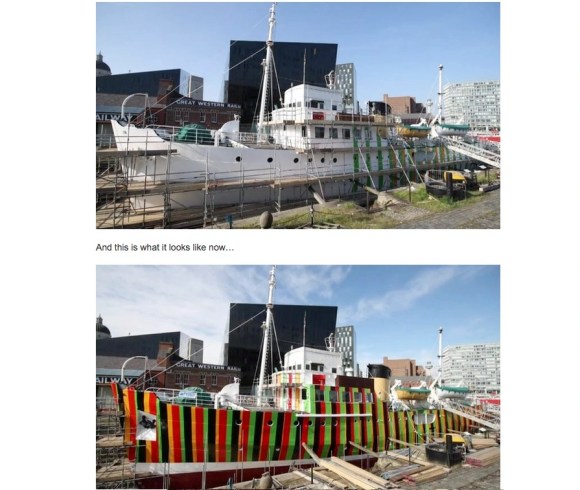
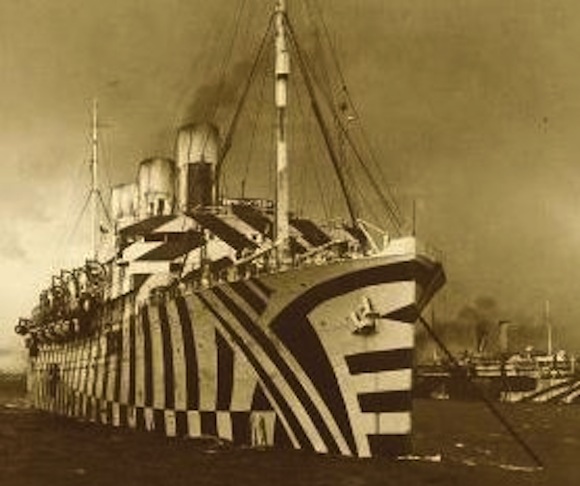
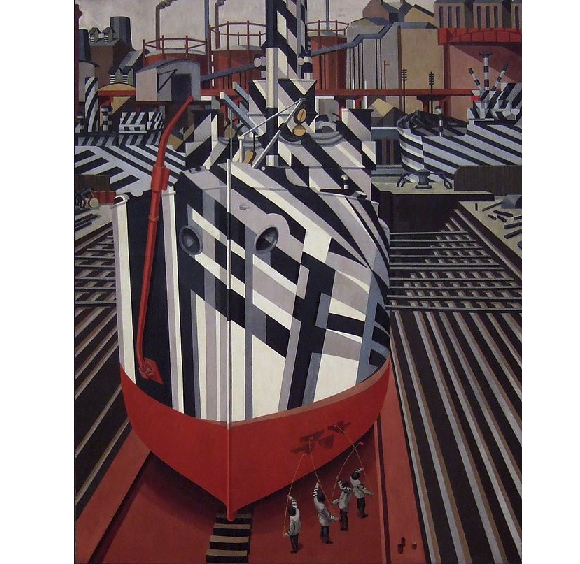

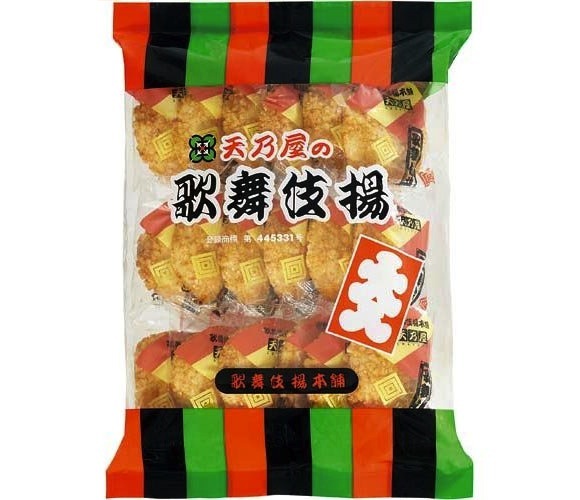
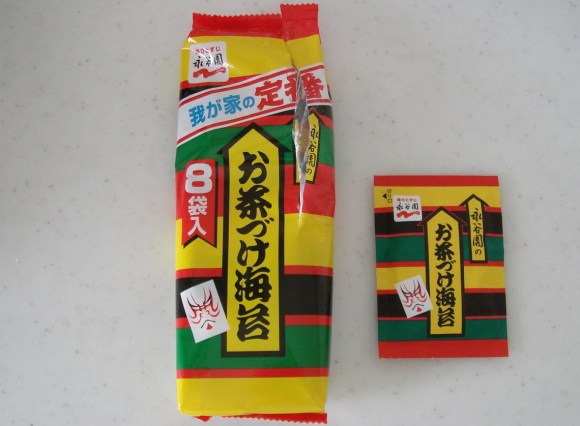
 Japanese beef bowl chain Sukiya’s 2026 Smile Box lucky bag basically pays for itself
Japanese beef bowl chain Sukiya’s 2026 Smile Box lucky bag basically pays for itself Top Japanese cosplayer Enako returns to Comiket after 6 years, creates mayhem with admirers
Top Japanese cosplayer Enako returns to Comiket after 6 years, creates mayhem with admirers Dragon Quest Burgers and Slime drinks are coming to McDonald’s Japan【Video】
Dragon Quest Burgers and Slime drinks are coming to McDonald’s Japan【Video】 Rakuten randomly offers 58 New Year’s osechi feasts in Japan, but did we get a star or a dud?
Rakuten randomly offers 58 New Year’s osechi feasts in Japan, but did we get a star or a dud? Things get heavy with the Gold Lucky Bag from Village Vanguard
Things get heavy with the Gold Lucky Bag from Village Vanguard Japanese beef bowl chain Sukiya’s 2026 Smile Box lucky bag basically pays for itself
Japanese beef bowl chain Sukiya’s 2026 Smile Box lucky bag basically pays for itself Top Japanese cosplayer Enako returns to Comiket after 6 years, creates mayhem with admirers
Top Japanese cosplayer Enako returns to Comiket after 6 years, creates mayhem with admirers Dragon Quest Burgers and Slime drinks are coming to McDonald’s Japan【Video】
Dragon Quest Burgers and Slime drinks are coming to McDonald’s Japan【Video】 Rakuten randomly offers 58 New Year’s osechi feasts in Japan, but did we get a star or a dud?
Rakuten randomly offers 58 New Year’s osechi feasts in Japan, but did we get a star or a dud? Things get heavy with the Gold Lucky Bag from Village Vanguard
Things get heavy with the Gold Lucky Bag from Village Vanguard 9 middle-aged Japanese men try putting on their own makeup
9 middle-aged Japanese men try putting on their own makeup Nearly one in ten young adults living in Japan isn’t ethnically Japanese, statistics show
Nearly one in ten young adults living in Japan isn’t ethnically Japanese, statistics show The Purple Lucky Bag from Village Vanguard is an extra-large waste of money
The Purple Lucky Bag from Village Vanguard is an extra-large waste of money Private booths are coming to Japan’s Shinkansen bullet trains even sooner than we’d thought【Video】
Private booths are coming to Japan’s Shinkansen bullet trains even sooner than we’d thought【Video】 More JSDF recruitment posters get a moe makeover in Ibaraki
More JSDF recruitment posters get a moe makeover in Ibaraki Starbucks Japan ready to get Year of the Horse started with adorable drinkware and plushies【Pics】
Starbucks Japan ready to get Year of the Horse started with adorable drinkware and plushies【Pics】 Hayao Miyazaki says Happy New Year to Studio Ghibli fans with new art for Year of the Horse
Hayao Miyazaki says Happy New Year to Studio Ghibli fans with new art for Year of the Horse Cup Noodle tries an authentic Jiro-style ramen, but something’s not quite right
Cup Noodle tries an authentic Jiro-style ramen, but something’s not quite right The best Starbucks Japan Frappuccinos we want to drink again in 2026
The best Starbucks Japan Frappuccinos we want to drink again in 2026 We revisited Sweets Paradise after a decade to see if Japan’s dessert buffet still delivers
We revisited Sweets Paradise after a decade to see if Japan’s dessert buffet still delivers That time Seiji called JASRAC to ask why he didn’t get paid royalties for his song being on TV
That time Seiji called JASRAC to ask why he didn’t get paid royalties for his song being on TV We found possibly the quietest Japanese-style hotel in Tokyo’s bustling Shinjuku district
We found possibly the quietest Japanese-style hotel in Tokyo’s bustling Shinjuku district Pizza Hut Japan’s hot lucky bags are perfect for a New Year’s pizza party
Pizza Hut Japan’s hot lucky bags are perfect for a New Year’s pizza party Japan’s oldest largetooth sawfish in captivity back on display in Mie Prefecture
Japan’s oldest largetooth sawfish in captivity back on display in Mie Prefecture 7-Eleven Japan starts new temporary luggage storage service in over 300 branches
7-Eleven Japan starts new temporary luggage storage service in over 300 branches Disillusionment at Tsukiji’s tourist-target prices led us to a great ramen restaurant in Tokyo
Disillusionment at Tsukiji’s tourist-target prices led us to a great ramen restaurant in Tokyo Starbucks teams up with 166-year-old Kyoto doll maker for Year of the Horse decorations【Photos】
Starbucks teams up with 166-year-old Kyoto doll maker for Year of the Horse decorations【Photos】 Tokyo considering law requiring more trash cans following litter increase in heavily touristed area
Tokyo considering law requiring more trash cans following litter increase in heavily touristed area Tokyo’s Tsukiji sushi neighborhood asks tour groups to stay away for the rest of the month
Tokyo’s Tsukiji sushi neighborhood asks tour groups to stay away for the rest of the month Tokyo event lets you travel back in time, for free, to celebrate 100 years since Showa era start
Tokyo event lets you travel back in time, for free, to celebrate 100 years since Showa era start Japan may add Japanese language proficiency, lifestyle classes to permanent foreign resident requirements
Japan may add Japanese language proficiency, lifestyle classes to permanent foreign resident requirements Sanrio theme park in Japan announces plans to expand into a Sanrio resort
Sanrio theme park in Japan announces plans to expand into a Sanrio resort Stamina-destroying “Paralysis Noodles” are Tokyo’s newest over-the-top ramen innovation
Stamina-destroying “Paralysis Noodles” are Tokyo’s newest over-the-top ramen innovation Survey asks foreign tourists what bothered them in Japan, more than half gave same answer
Survey asks foreign tourists what bothered them in Japan, more than half gave same answer Japan’s human washing machines will go on sale to general public, demos to be held in Tokyo
Japan’s human washing machines will go on sale to general public, demos to be held in Tokyo Japan’s deadliest food claims more victims, but why do people keep eating it for New Year’s?
Japan’s deadliest food claims more victims, but why do people keep eating it for New Year’s? We deeply regret going into this tunnel on our walk in the mountains of Japan
We deeply regret going into this tunnel on our walk in the mountains of Japan Studio Ghibli releases Kodama forest spirits from Princess Mononoke to light up your home
Studio Ghibli releases Kodama forest spirits from Princess Mononoke to light up your home Major Japanese hotel chain says reservations via overseas booking sites may not be valid
Major Japanese hotel chain says reservations via overseas booking sites may not be valid Put sesame oil in your coffee? Japanese maker says it’s the best way to start your day【Taste test】
Put sesame oil in your coffee? Japanese maker says it’s the best way to start your day【Taste test】 No more using real katana for tourism activities, Japan’s National Police Agency says
No more using real katana for tourism activities, Japan’s National Police Agency says Starbucks Japan reveals new sakura drinkware collection, inspired by evening cherry blossoms
Starbucks Japan reveals new sakura drinkware collection, inspired by evening cherry blossoms Updated cherry blossom forecast shows extra-long sakura season for Japan this year
Updated cherry blossom forecast shows extra-long sakura season for Japan this year 9 middle-aged Japanese men try putting on their own makeup
9 middle-aged Japanese men try putting on their own makeup Nearly one in ten young adults living in Japan isn’t ethnically Japanese, statistics show
Nearly one in ten young adults living in Japan isn’t ethnically Japanese, statistics show The Purple Lucky Bag from Village Vanguard is an extra-large waste of money
The Purple Lucky Bag from Village Vanguard is an extra-large waste of money Private booths are coming to Japan’s Shinkansen bullet trains even sooner than we’d thought【Video】
Private booths are coming to Japan’s Shinkansen bullet trains even sooner than we’d thought【Video】 More JSDF recruitment posters get a moe makeover in Ibaraki
More JSDF recruitment posters get a moe makeover in Ibaraki Is the new Shinkansen Train Desk ticket worth it?
Is the new Shinkansen Train Desk ticket worth it? What makes a good boss in Japan? Workers sound off in survey
What makes a good boss in Japan? Workers sound off in survey More Than a Capsule Stay: Why Solo Travelers Choose “global cabin Yokohama Chinatown”
More Than a Capsule Stay: Why Solo Travelers Choose “global cabin Yokohama Chinatown” Happy New Year from SoraNews24!
Happy New Year from SoraNews24! Majority of Japanese mayors say foreign residents are essential but most see good and bad effects
Majority of Japanese mayors say foreign residents are essential but most see good and bad effects Solo sukiyaki! Cook-in-the-counter hot pot is newest way to treat yourself to great food in Tokyo
Solo sukiyaki! Cook-in-the-counter hot pot is newest way to treat yourself to great food in Tokyo Roughly one in eight of Tokyo’s new adults is foreign-born, study shows
Roughly one in eight of Tokyo’s new adults is foreign-born, study shows Mt. Fuji schoolgirl photo models who charmed Japan years ago reunite to celebrate Coming of Age Day
Mt. Fuji schoolgirl photo models who charmed Japan years ago reunite to celebrate Coming of Age Day
Leave a Reply